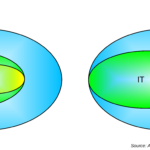History Matters
Following the historical evolution of the Internet and Cyberspace sheds light on the origins of the “superhighway” and “virtual” metaphors, depicted in the first part of this post. Useful summaries from a pure infrastructural perspective are available from the NFS and UCSD, the latter furnishing cool schematic diagrams of the overall network architecture. That said, the critical point here is that much-needed telecom infrastructure was still conspicuously absent by the mid-1990, despite accelerated internetwork growth. In 1995, when the NSFNet was privatized, infrastructure development was thus still incipient globally. Infrastructural imaginaries such as “turnpikes” and “highways” thus played a crucial role in driving that point home. Invest in access and connectivity, or the train will leave the station without you, no apologies will be issued. On the other hand, the “virtual” was still being engendered, as only a selected few could access the then-emerging World Wide Web.
Needless to say, developing countries were not part of the equation at that point -with a few exceptions, such as India and Chile, where academic institutions had been able to join the nascent network. And they have been playing catch-up ever since. Uneven development is thus one of Cyberspace’s development traits -albeit not unique to such a realm. Nevertheless, such unevenness showcases the limited relevance of the “superhighway” metaphor for countries where real and tangible highways and turnpikes were hard to find. Of course, people in such geographies might have seen that infrastructure in films or good old analog photos but never experienced them firsthand. In any event, that puts into question the metaphor’s universal claims. This also needs to be thus challenged, but that is another story that demands its own real estate. 
The “virtual” metaphor stems from at least two sources. First is the emergence of Cyberculture and Digital Utopia in the U.S., well detailed in Turner’s 2006 book – although I would argue that the fiction books of Ayn Rand (not her philosophical works) also played a fundamental role here. In any case, my focus is much narrower here as I am looking at the virtual components of such cyberculture. A great example is Barlow’s 1996 declaration of the independence of Cyberspace. “I come from Cyberspace, the new home of Mind” is part of the opening shot. I am sure he is not thinking about Hegel here. But there is more.
“Ours is a world that is both everywhere and nowhere, but it is not where bodies live…Our identities have no bodies… Our identities may be distributed across many of your jurisdictions…In our world, whatever the human mind may create can be reproduced and distributed infinitely at no cost. The global conveyance of thought no longer requires your factories to accomplish. We must declare our virtual selves immune to your sovereignty… We will spread ourselves across the Planet so that no one can arrest our thoughts. We will create a civilization of the Mind in Cyberspace.”
The second source, usually not acknowledged, is Guy Debord’s pioneering work, best presented in his Society of the Spectacle.
“The images detached from every aspect of life fuse in a common stream in which the unity of this life can no longer be reestablished. Reality considered partially unfolds, in its own general unity, as a pseudo-world apart, an object of mere contemplation. The specialization of images of the world is completed in the world of the autonomous image, where the liar has lied to himself. The spectacle in general, as the concrete inversion of life, is the autonomous movement of the non-living.”
Amazingly, that sounds like a sophisticated description of Instagram and parts of Facebook. Although he wrote the above before Arpanet was created, Debord highlighted that even in the analog world, the “virtual” was rapidly emerging in societies where capitalism was well advanced. The digital “virtual” thus has a counterpart in the analog world. Moreover, Debord was well aware of the uneven global development of the phenomena he uncovered, unlike those pushing the digital “virtual.” Although his views could also be linked to the post-industrial society argument, Debord’s focus on images as social relationships resonates loudly today. And the “superhighway” metaphor seems pretty useless here.
Revolutions Galore
On top of its addiction to metaphors, Cyberspace also seems enamored of revolutions. We are repeatedly reminded that the number of revolutions it has experienced is large. And it looks excessive for an entity still in its early thirties, I should add. The theory of the Permanent Revolution could be helpful here. However, Cyberspace revolutions are not social but essentially technological, peacefully driven by innovation and intense competition among firms incessantly trying to get ahead of the rest. Of course, technological revolutions have a discerning social impact. But that only occurs in the medium and long term, and, in any case, they rarely challenge the status quo for good. Moreover, technological revolutions are always associated with the idea of progress as they lead humanity closer to a usually undefined paradise. The Enlightenment on steroids is finally here, alas.
The Internet revolution must be the maiden tech revolt. Nevertheless, I will argue that such a tectonic shift was only felt by a few, mostly the academic institutions benefitting from free access to the internetwork back in the early days. And I must admit I was part of such an elite team. While email was touted as the “killer app,” I loved to use telnet, which allowed me to access a remote server, my identity now “being distributed across many jurisdictions.” And I thought Gopher was also super cool.
However, it was killed on the spot by the next Cyberspace upheaval, the Web revolution. While the WWW protocol was developed between 1989 and 1991, its real impact was only felt when the first Web client, Mosaic, was released to the public in early 1993. It sent tremors all around the globe. I remember downloading Mosaic version 0.10 and being floored by its potential impact, even though very few websites were up and running. I also did quite a few demos for colleagues and stakeholders while traveling all over the place and seeing the same reaction on their faces. This was a real game changer, a clarion call to beat the “superhighway” metaphor at all costs to immerse ourselves into Cyberpsace’s “virtual” nirvana. So the second Cyberspace revolution was indeed deeper and broader than the first. And it unleashed Internet growth by leaps and bounds. Netscape was created the following year and we soon found ourselves amid the browser’s war between a startup trying to become a behemoth and a behemoth trying to stop it by any means.
Then came what I call the “e” revolution, supported by a proliferation of startups pushing all sorts of stuff ranging from e-commerce and e-business to (e-)pets and e-love, which led to the dot-com bubble. Its subsequent crash marked the end of an era where the Internet had a spotless record. Not anymore. However, help came from unexpected quarters, the mobile revolution that caught many Cyberspace pundits by surprise. Indeed, mobiles have contributed substantially to developing Cyberspace’s “superhighway,” especially on the demand side. This was followed by the social media revolution, the data and big data revolution, the Bitcoin and blockchain revolution, the AI revolution (or rebirth) and, more recently, the ChatGPT revolution, which can be seen as the opening shot of the upcoming AGI super-revolution, so they predict.
Two in One is One
While consensus on a definition of Cyberspace is still in the wings, its history does shed light on the significance and relevance of the metaphors deployed to explain its inner core. First, we can point out that the two central metaphors, “superhighways” and “virtual,” are not historically sequential but have indeed co-existed most of the time. That is partly the result of Cyberspace’s uneven development globally, almost in total sync with capitalist development around the globe. A few are well ahead of most, even if a few are comprised of millions. For example, Barlow’s declaration of independence was posted when most of the world’s population had hardly heard about or accessed the Internet. To them, that text probably sounded more like a work of Cyberfiction. On the other hand, “superhighways” seemed much more plausible. So both metaphors made sense, depending on your local context.
However, the metaphors are, at the same time, logically sequential. “Superhighways” or “tubes” must exist at specific geographical locations for any user to access the “virtual” world. There is no other way to reach such a paradise. That partly explains the big 1990s push to close the so-called digital divide. Turnpikes provided the right Imaginary to make this case. The mobile revolution accomplished precisely the same as what Marconi’s wireless telegraph did for telecommunications in the late 19th Century. Highways can be immaterial, invisible, and still take me directly to heaven. At this point, the highway metaphor loses steam as we now use “virtual” turnpikes, intangibles that bring tangible benefits to end users. It thus seems that the “virtual” world is omnipresent and there is no way to avoid it.
Notwithstanding, such pipedream quickly falls apart when we visit the supply side and check, for example, the vast submarine fiber optic infrastructure deployed in the last 30 years. But end users are unaware of such complex telecommunication networks in the same way they are unaware of the networks bringing them electricity, water or gas. But they are quickly reminded of their existence when services fail. The sharp separation between distribution and consumption reinforces the omnipresence of the virtual in Cyberspace as I, as a user, could not care less about what is behind the scenes as long as I can stay smoothly connected to the virtual. And when my link goes down, all I need is a quick fix to keep the addiction going at the speed of light.
Ultimately, the two apparently antagonistic metaphors are the two sides of the same coin. One cannot exist without the other. Furthermore, their interplay generates a new dynamic entity that cannot be explained by just looking at one side of the coin. Unlike Barlow, I am thinking about Hegel here.
Raúl






